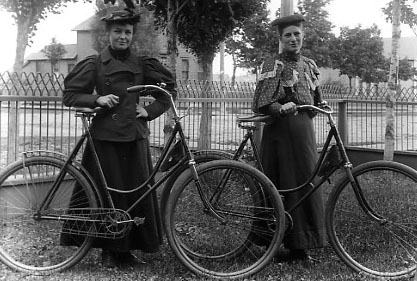The safety bicycle, or what most people think of simply as a bicycle, is one of the most thoroughly discussed aspects of bicycle history. I have over half a dozen books that discuss its development in great detail. More books continue to be written, and it appears that there is still more to be said on the subject. Given the sheer amount of information available, I am barely going to scratch the surface here.
The high-wheel clearly was not safe, although its danger was part of its appeal. Still, some bicycle designers were interested in making a safer bicycle and came up with a number of different designs. Unlike modern bicycles, the earliest safety bicycle still did not have equally sized wheels, although they were much closer in size than a high-wheels two wheels. None of these early designs were as elegant as the high-wheel, but they demonstrate the experimentation that occurred on the way to modern bicycles.
In 1885, British cycling manufacturers debuted the first “diamond frame” bicycles. Of course, as Tony Hadland and Hans-Erhard Lessing showed in Bicycle Deisgn: An Illustrated History, they are not truly diamond shaped, but it’s fairly clear why we call them that. These bicycles still did not have equally sized wheels, but it did not take long for manufacturers to make this change. Unlike the high-wheel and the velocipede, these bicycles are rear-driven. Rear-driven bicycles typically are chain driven.

Proponents of the high-wheel did not immediately adopt the safety bicycle, which some men thought unmasculine. As David V. Herlihy described in Bicycle, when safety bicycle technology improved it became apparent that the high-wheel’s heyday was coming to a close. One of the most important improvements was the pneumatic tire, which increased both comfort and speed. As racers found that they could ride faster on the safety bicycle than on the high-wheel, they quickly switched over. By the early 1890s, the safety bicycle had become the norm. The height of the bicycle boom occurred between 1895 and 1897, but bicycling culture was important throughout the 1890s.

The safety bicycle was also better adapted for use by women, although riding a diamond frame in long skirts was not exactly feasible. Drop-frame (or step through) bicycles made it possible for women to give up their tricycles in favor of less cumbersome bicycles. The first drop-frame bicycles designed particularly for women were introduced in both Britain and the United States in 1887. Interestingly, many American women adopted the bicycle before their British counterparts, some of whom continued to ride tricycles into the 1890s.
In 1889, the first mass-produced women’s bicycle, known as the Pscyho ladies’ bicycle (yes, that’s its real name), was introduced in Britain and soon imported to the United States. The drop-frame bicycle, like the tricycle, made it possible for women to ride in conventional clothing. However, it was not without flaws. For one thing, drop-frame bicycles were heavier and had less structural integrity. In addition, women’s skirts were still a hazard, so the bicycles tended to be equipped with a chain guard, a skirt guard, and fenders. All of these accouterments made them even heavier.
Some people probably thought women’s heavier bicycles were for the best, it was frowned upon for women to ride too quickly (known as scorching). Even a heavy bicycle was less cumbersome than a tricycle– and less expensive, and women took to it in scores. There are no precise numbers, but Ross Petty estimated that by 1896 there were between 1.3 and 3.25 million women riding bicycles in Britain, France, Germany, and the United States. David V. Herlihy wrote that women purchased about one third of bicycles in the United States. So, women were a significant percentage of the market in the 1890s.

Women faced obstacles to becoming bicyclists, but it was easier for Anglo women of means to be accepted than it was for black cyclists such as the bicycle champion Marshall Walter “Major” Taylor. Major Taylor was not allowed to race against white cyclists in the Southern United states. In 1892, The League of American Wheelmen (LAW) stated that men of all races could join, but in 1894 black individuals were banned from joining, partially due to pressure from southern members. This topic, like the topic of gender in bicycling, is too important to be addressed in one paragraph (or one post). Jesse Gant’s post “Whites on Bikes” addresses racial exclusivity during the nineteenth century, although of course racism continues to be an issue in modern bicycling.


